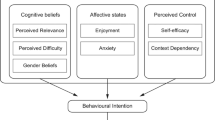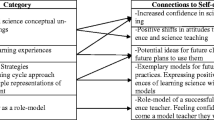Abstract
The purpose of this study was to examine preservice elementary teachers’ understanding of the concepts of photosynthesis and inheritance, to explore their self-efficacy beliefs in the teaching of science, and to investigate the relationship between these two issues. Data was gathered through the use of a misconception instrument and science teaching efficacy beliefs instruments. Seventy-nine preservice elementary teachers participated in this study. The results showed that participants held alternative conceptions regarding photosynthesis and inheritance and have generally positive self-efficacy beliefs regarding science teaching. The results also suggested that those participants with fewer alternative conceptions regarding photosynthesis had relatively high personal science teaching efficacy. Teachers are clearly a central component for student success in learning science; however, in 1983, Feistritzer and Boyer reported that among elementary teachers, understanding science concepts was at a low level. Previous studies have shown that elementary teachers often have negative attitudes toward science (Shrigley, 1974), have science anxiety (Czerniak & Chiarelott, 1990), have low science interest (Tilgner, 1990), and do not have confidence in their ability to teach science (DeTure, Gregory, & Ramsey, 1990). Studies also have found that elementary teachers generally possess a low level of knowledge regarding the concepts, facts, and skills concerning science (Stevens & Wenner, 1996; Victor, 1962; Wenner, 1993). A number of studies have documented that both preservice and inservice elementary teachers frequently hold alternative conceptions (or misconceptions) for a variety of science concepts and harbor misunderstandings (Atwood & Atwood, 1996; Schoon, 1993; Schoon & Boone, 1998). This often causes elementary teachers to avoid teaching science to children (Czerniak & Chiarelott, 1990; Westerback, 1982) or to spend less time teaching science in comparison to other subjects (Westerback, 1982).
Similar content being viewed by others
References
Amir, R., & Tamir, P. (1994). In-depth analysis of misconceptions as a basis for developing research-based remedial instruction: The case of photosynthesis.The American Biology Teacher, 56, 94–100.
Anderson, C., Sheldon, T., & Dubay, J. (1990). The effects of instruction on collage nonmajors’ conceptions of respiration and photosynthesis.Journal of Research in Science Teaching, 27, 761–776.
Arnaudin, M. W., & Mintzes, J. J. (1985). Students’ alternative conceptions of the circulatory system: A cross-age study.Science Education, 69, 721–733.
Ashton, P. T. (1984). Teacher efficacy: A motivational paradigm for effective teacher education.Journal of Teacher Education, 35, 38–32.
Ashton, P. T., & Webb, R. B. (1986).Making a difference: Teacher’s sense of efficacy and student achievement. New York: Longman.
Atwood, R. K., & Atwood, V. A. (1996). Preservice elementary teachers’ conceptions of the causes of seasons.Journal of Research in Science Teaching, 33, 553–563.
Bandura, A. (1977). Self-efficacy: Toward a unifying theory of behavior change.Psychological Review, 84, 191–215.
Bandura, A. (1982). Self-efficacy mechanism in human agency.American Psychologist, 37, 122–147.
Bandura, A. (1986).Social foundations of thought and action: A social cognitive theory. Englewood Cliffs, NJ: Prentice Hall.
Barrass, R. (1984). Some misconceptions and misunderstandings perpetuated by teachers and textbooks of biology.Journal of Biological Education, 18, 201–206.
Crawley, F. E., & Arditzoglou, S. Y. (1988).Life and physical science misconceptions of preservice elementary teachers. Paper presented at the Annual Meeting of the School Science and Mathematics Association, Austin, TX.
Czerniak, C., & Chiarelott, L. (1990). Teacher education for effective science instruction: A social cognitive perspective.Journal of Teacher Education, 41, 49–58.
DeTure, L. R., Gregory, E., & Ramsey, B. G. (1990).The science preparation of elementary teachers. Paper presented at the Annual Meeting of the National Association for Research in Science Teaching Atlanta, GA.
Duit, R., & Treagust, D. F. (1995). Students’ conceptions and constructivist teaching approaches. In D. J. Fraser & H. J. Walberg (Eds.),Improving science education (pp 90–116). Chicago: The University of Chicago Press.
Eisen, Y., & Stavy, R. (1988). Students’ understanding of photosynthesis.American Biology Teacher, 50, 208–212.
Enochs, L. G., & Gabel, D. (1984). Preservice elementary teachers’ conceptions of volume.School Science and Mathematics, 84, 670–680.
Enochs, L. G., & Riggs, I. M. (1990). Further development of an elementary science teaching efficacy belief instrument: A preservice elementary scale.School Science and Mathematics, 90, 694–706.
Feistritzer, E. C., & Boyer, E. L. (1983).The conditions of teaching: A state by state analysis. Princeton, NJ: The Carnegie Foundation for the Advancement of Teaching.
Ginns, I. S., & Watters, J. J. (1990).A longitudinal study of preservice elementary teachers’ personal and science teaching efficacy. (ERIC Document Reproduction Service No. 404 127)
Green, K. E. (1996). Applications of the Rasch model to evaluation of survey data quality. In M. T. Bravermann & J. K. Slater (Eds.),Advances in survey research (pp. 81–92). San Francisco: Jossey-Bass.
Greenwood, A., & Scribner-MacLean, M. (1997).Examining elementary teachers’ explanations of their science content knowledge. A paper presented at the Annual Meeting of the National Association for Research in Science Teaching, Oak Brook, IL. (ERIC Document Reproduction Service No. 406 161)
Haslam, F., & Treagust, D. F. (1987). Diagnosing secondary students’ misconceptions of photosynthesis and respiration in plants using a two-tier multiple choice instrument.Journal of Biological Education, 21, 203–211.
Kargbo, D. B., Hobbs, E. D., & Erickson, G. L. (1980). Children’s beliefs about inherited characteristics.Journal of Biological Education, 14, 137–146.
Linacre, J. M., & Wright, B. D. (1996).Bigsteps Rasch-model computer program (Version 2.6) [Computer Software]. Chicago: MESA Press
McDevitt, T. M., Heikkinen, H. W., Alcorn, J. K., Ambrosio, A. L., & Gardner, A. L. (1993). Evaluation of the preparation of teachers in science and mathematics: Assessment of preservice teachers’ attitudes and beliefs.Science Education, 77, 593–610.
Nussbaum, J., & Novick, S. (1982). Alternative frameworks, conceptual conflicts and accommodation: Toward principled teaching strategy.Instructional Science, 11, 183–200.
Ramey-Gassert, L., & Shroyer, M. G. (1992). Enhancing science teaching self-efficacy in preservice elementary teachers.Journal of Elementary Science Education, 4, 26–34.
Riggs, I. M., & Enochs, L. G. (1990). Toward the development of an elementary teacher’s science teaching efficacy belief instrument.Science Education, 74, 625–637.
Schoon, K. J. (1993).The origin of earth and space science misconceptions: A survey of preservice elementary teachers. A paper presented at the Third Misconceptions Seminar Proceedings, Cornell University, Ithaca, New York.
Schoon, K. J., & Boone, W. J. (1998). Self-efficacy and alternative conceptions of science of preservice elementary teachers.Science Education, 82, 553–568.
Shrigley, R. L. (1974). The correlation of science attitude and science knowledge of preservice elementary teachers.Science Education, 58, 143–151.
Songer, C. J., & Mintzes, J. J. (1993).Understanding cellular respiration. A paper presented at the International Symposium from Misconceptions to Constructed Understanding, Cornell University, Ithaca, New York.
Stepans, J., Dyche, S., & Beiswenger, R. (1988). The effect of two instructional models in bringing about a conceptual change in the understanding of science concepts by prospective elementary teachers.Science Education, 72, 185–195.
Stepans, J., & McCormack, A. (1985).A study of scientific conceptions and attitudes toward science of prospective elementary teachers: A research report. (ERIC Document Reproduction Service No. ED 266 024)
Stevens, C., & Wenner, G. (1996). Elementary preservice teachers’ knowledge and beliefs regarding science and mathematics.School Science and Mathematics, 96, 2–9.
Tilgner, P. J. (1990). Avoiding science in the elementary school.Science Education, 74, 421–431.
Trowbridge, J. E., & Mintzes, J. J. (1985). Alternative conceptions in animal classification: A cross-age study.Journal of Research in Science Teaching.25, 304–316.
Victor, E. (1962). Why are our elementary school teachers reluctant to teach science?Science Education, 46, 185–192.
Wandersee, J. H. (1985). Can the history of science help science educators anticipate students’ misconceptions?Journal of Research in Science Teaching, 23, 581–597.
Wandersee, J. H., Mintzes, J. J., & Novak, J. D. (1994). Research on alternative conceptions in science. In D. Gabel (Ed.),Handbook of research on science teaching and learning (pp. 177–210). New York: Macmillan.
Wenner, G. J. (1993). Relationship between science knowledge levels and beliefs toward science instruction held by preservice elementary teachers..Journal of Science Education and Technology, 2, 461–468.
Westbrook, S. L., & Marek, E. A. (1991). A cross-age study of student understanding of the concept of diffusion.Journal of Research in Science Teaching, 28, 649–660.
Westerback, M. (1982). Studies on anxiety about teaching science in preservice elementary teachers.Journal of Research in Science Teaching, 21, 937–950.
Wood-Robinson, C. (1995). Children’s biological ideas: Knowledge about ecology, inheritance and evolution. In S. M. Glynn & R. Quit (Eds.),Learning science in the schools: Research reforming practice (pp. 111–130). Mahwah, NJ: Lawrence Erlbaum Associates.
Author information
Authors and Affiliations
Corresponding author
Rights and permissions
About this article
Cite this article
Cakiroglu, J., Boone, W.J. Preservice elementary teachers’ self-efficacy beliefs and their conceptions of photosynthesis and inheritance. J Elem Sci Edu 14, 1–14 (2002). https://doi.org/10.1007/BF03174733
Accepted:
Issue Date:
DOI: https://doi.org/10.1007/BF03174733




